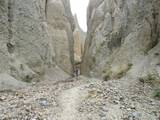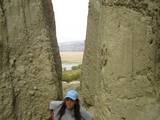Wanaka to the MacKenzie Country - 6/03/2012 to 7/03/2012
Tuesday morning - We headed to Twizel via Tarras, where we stopped briefly at a collection of country stores. One of the buildings houses part of the 25kg fleece from the world famous sheep, Shrek, who had avoided being shorn for some years on the hills of Bendigo Station. There are cartoons, paintings and newspaper articles of him and his fleece from the first shearing and another of him being later shorn on the large iceberg that came near NZ several years ago. Small trivia, but headline news at the time for a town so small.
After driving through the Lindis Pass, rolling hills carpeted in golden tussock flanked by purple and pink lupins, we arrived at Omarama. There are plenty of places to do a coffee review here and being situated on a main junction it is a stopping point for tourist buses. Because of the thermal draughts it creates the perfect flying conditions for gliders and therefore has a large aerodrome to accommodate them. This is where Richie McCaw hangs out (glides) when he’s not being Captain Fantastic.
Omarama is also just down the road from the Clay Cliffs. For a small fee you can go on private land to see and walk amongst deep gullies and tall pillar-like formations resulting from water erosion over millions of years. They are quite impressive and very tall as you can probably work out from the photos. We were lucky that a visit to the Clay Cliffs was recommended to us as the road signs don’t really give you any indication what the landmark is or that you are suppose to pay in town first (there was an honesty box at the gate).
The Clay Cliffs were in our travel book which we had to use to find them. When we got our bus my brother gave us a book on natural wonders of NZ which has been really useful for finding impressive sights you wouldn’t otherwise know about like off the road waterfalls and lakes, which It lists in geeographic route order. It also gives you all sorts of facts, so if you are into natural landmarks I highly recommend “Touring the Natural Wonders of New Zealand” by Peter Janssen.
Our next destination was the MacKenzie Country and its many lakes, both glacier formed and man-made (yahoo, more hydro power stations), but we didn’t even get past Ruataniwha, home to South Island Rowing. The salmon farm at one end of the lake and the motorhomers parked up fishing caught our eye; the colour of the water is breathtaking. The book (previously mentioned) describes the icy waters as iridescent blue, resulting from minuscule particles of rock ground to a fine powder and being washed down by the glaciers and remaining in suspension in the water. We drove around the campground and rowing facilities at Lake Ruataniwha; the wind was not conducive to rowing today, hmmm... The campground was looking very arid and a long way from the rowing, hmmm... We got an email with our Maadi cup roster today; there appears to be a lack of South Island boat drivers and a lot of Karapiro volunteers on boat driving, hmmm... I’m happy, I have been allocated boat number issuing, hopefully an inside job, although I think Roger is perplexed that everyone assumes an accountant knows how to count. 1 to 8 is easy, it’s the alphabet I have trouble with [there is ocasionally problems with the numbers between 1 and 8 also - Ed].
Wednesday morning we went to Twizel to do our washing at the only over-priced launderette. I am constantly surprised how many parents let their kids travel the world without teaching them the basics. I had to help two European boys; they couldn’t open the soap powder box, let alone read it and they didn’t know it came with a scoop, so they couldn’t work out how to measure the powder. They were insistent on trying to put three loads of washing into one machine to try and save money. But they did diligently read all the washing instructions on each item before asking me if orange towels could be washed with white T-Shirts (my biggest fear is dye running, so much so that Roger has had to abandon certain red items to keep the peace).
After washing we drove up the 63km long road to Mt Cook now known as Aoraki/Mt Cook.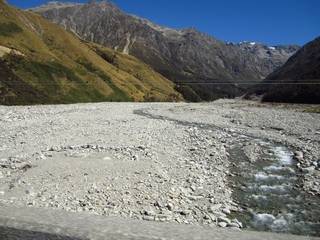 The rivers under the bridges are a sight, they get so violent they have hurled large rocks down the mountain and scarred the landscape. Unfortunately Mt Cook was in cloud along with the Tasman Glacier. As the road is extremely good for driving on we decided to return when the weather is more befitting to mountain viewing. Meanwhile we spent 3 hours at Mt Cook Village doing coffee reviews, learning about glaciers and mountaineers at the DOC visitors centre and at the Hermitage’s Sir Edmund Hilary Alpine Centre. In case you can’t work out from the photo, Roger is the one wearing jandals, Sir Ed is the other one. There were lots of people out doing day walks in the cold and visiting the information centre. They were all dressed in thermals, hiking boats, windbreakers and woollens, unlike the visitors from Karapiro who came in jeans and jandals.
The rivers under the bridges are a sight, they get so violent they have hurled large rocks down the mountain and scarred the landscape. Unfortunately Mt Cook was in cloud along with the Tasman Glacier. As the road is extremely good for driving on we decided to return when the weather is more befitting to mountain viewing. Meanwhile we spent 3 hours at Mt Cook Village doing coffee reviews, learning about glaciers and mountaineers at the DOC visitors centre and at the Hermitage’s Sir Edmund Hilary Alpine Centre. In case you can’t work out from the photo, Roger is the one wearing jandals, Sir Ed is the other one. There were lots of people out doing day walks in the cold and visiting the information centre. They were all dressed in thermals, hiking boats, windbreakers and woollens, unlike the visitors from Karapiro who came in jeans and jandals.
Wednesday nights parking spot is one of the many free and popular areas around Lake Pukaki, the deepest lake of the seven in the Waitaki Hydro Scheme group. Seven lakes and eight power stations; I see Roger’s excitement levels rising. He has already done three and luckily for him they left a bloke in charge of naming the rest, Ohau A, B, C and Tekapo A and B won’t be hard to forget.

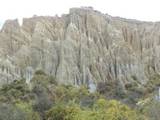
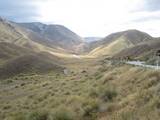
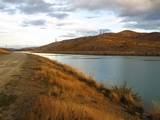

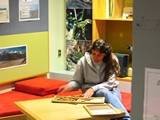
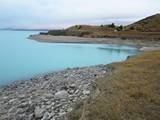
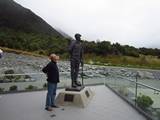
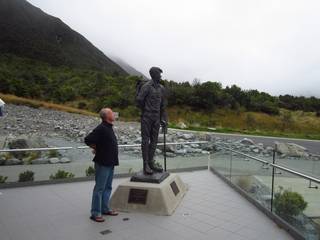 Mountaineers at Mt Cook
Mountaineers at Mt Cook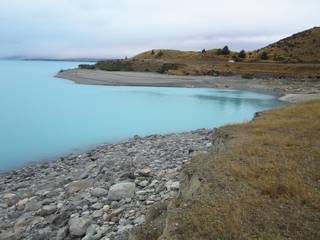 Lake Pukaki campsite
Lake Pukaki campsite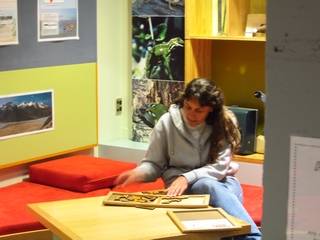 Puzzled at DOC Visitor's Centre
Puzzled at DOC Visitor's Centre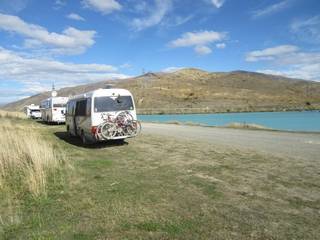 Parked at Canal near Ruataniwha
Parked at Canal near Ruataniwha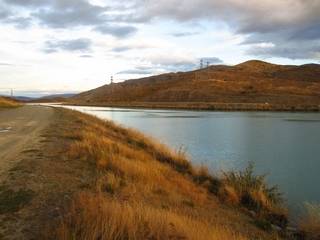 No fish but a lovely sunset
No fish but a lovely sunset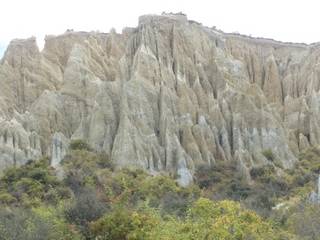 Clay Cliffs - near Omarama
Clay Cliffs - near Omarama